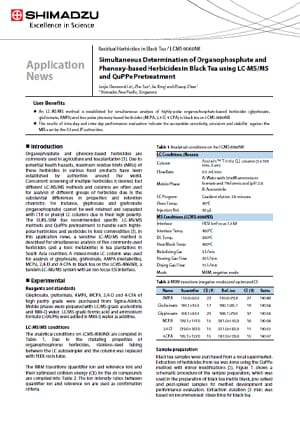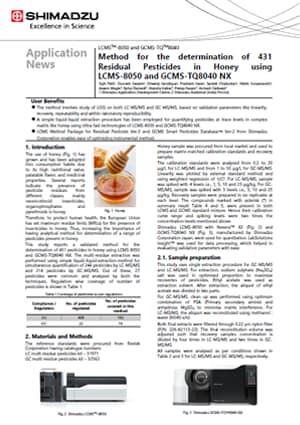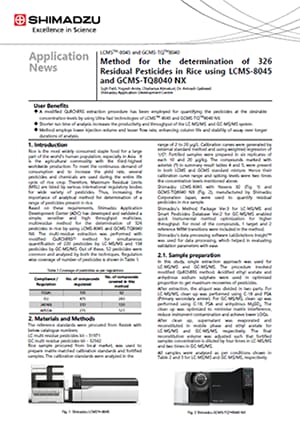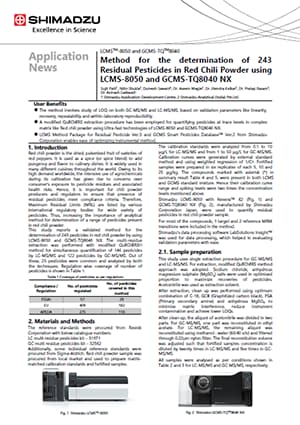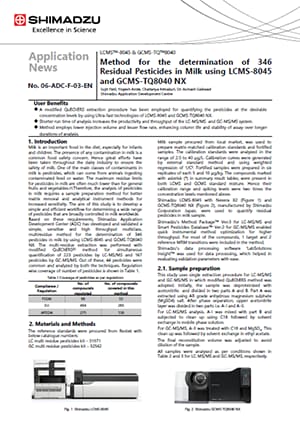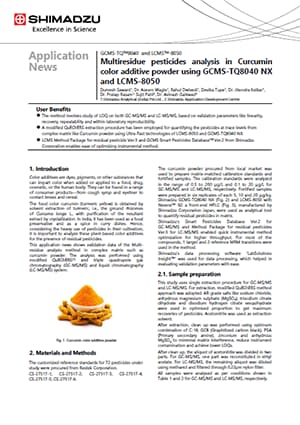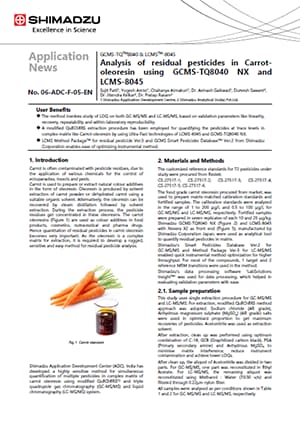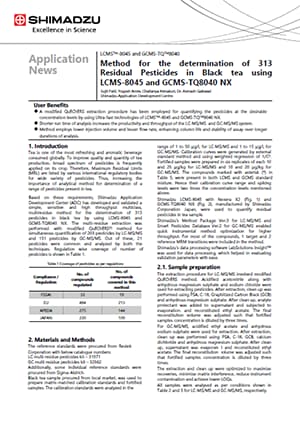Pesticides - Multiresidue Analysis in Various Food Matrices
Simultaneous Determination of Organophosphate and Phenoxy-based Herbicides in Black Tea using LC-MS/MS and QuPPePretreatment
Organophophate and phenoxy-based herbicides are commonly used in agriculture and tea plantation. Due to potential health hazards, maximum residue limits (MRLs) of these herbicides in various food products have been established by authorities around the world. Concurrent screening of multiple herbicides is desired, but different LC-MS/MS methods and columns are often used for analysis of different groups of herbicides due to the substantial differences in properties and retention chemistry. For instance, glyphosate and glufosinate (organophophate) cannot be well retained and separated with C18 or phenyl LC columns due to their high polarity. The EURL-SRM has recommended specific LC-MS/MS methods and QuPPe pretreatment to handle such highly-polar herbicides and pesticides in food commodities. In this application news, a sensitive LC-MS/MS method is described for simultaneous analysis of five commonly-used herbicides (andatoxicmetabolite) in tea plantations in South Asia countries. A mixed-mode LC column was used for analysis of glyphosate, glufosinate, AMPA(metabolite), MCPA, 2,4-D and 4-CPA in black tea on the LCMS-8060NX, a tandem LC-MS/MS system with an ion-focus ESI interface.
Method for the determination of 431 Residual Pesticides in Honey using LCMS-8050 and GCMS-TQ8040 NX
The use of honey has grown and has been adopted into consumption habits due to its high nutritional value, palatable flavor, and medicinal properties. Several reports indicate the presence of pesticide residues from different classes, mainly neonicotinoid insecticides, organophosphates and pyrethroids in honey.
Therefore, to protect human health, the European Union has set maximum residue limits (MRLs) for the presence of insecticides in honey. Thus, increasing the importance of having analytical method for determination of a range of pesticides present in honey.
This study reports a validated method for the determination of 431 pesticides in honey using LCMS-8050 and GCMS-TQ8040 NX. The multi-residue extraction was performed using simple liquid-liquid extraction method for simultaneous quantification of 244 pesticides by LC-MS/MS and 214 pesticides by GC-MS/MS. Out of these, 27 pesticides were common and analyzed by both the techniques.
Method for the determination of 326 Residual Pesticides in Rice using LCMS-8045 and GCMS-TQ8040 NX
Rice is the most widely consumed staple food for a large part of the world's human population, especially in Asia. It is the agricultural commodity with the third-highest worldwide production. To meet the continuous demand of consumption and to increase the yield rate, several pesticides and chemicals are used during the entire life cycle of rice crop. Therefore, Maximum Residual Limits (MRL) are listed by various international regulatory bodies for wide variety of pesticides. Thus, increasing the importance of analytical method for determination of a range of pesticides present in rice. Based on these requirements, Shimadzu Application Development Center (ADC) has developed and validated a simple, sensitive and high throughput multiclass, multiresidue method for the determination of 326 pesticides in rice by using LCMS-8045 and GCMS-TQ8040 NX. The multi-residue extraction was performed with modified QuEChERS method for simultaneous quantification of 220 pesticides by LC-MS/MS and 158 pesticides by GC-MS/MS. Out of these, 52 pesticides were common and analyzed by both the techniques.
Method for the determination of 243 Residual Pesticides in Red Chili Powder using LCMS-8050 and GCMS-TQ8040 NX
Gas chromatography/mass spectrometry (GC/MS) is an essential technique used for the analysis of residual contaminants in food products. To improve the signal quality, sample preparation is mandatory prior to introduction into these highly sensitive instruments. Conventionally, however, the sample preparation requires a long time and multistep efforts in which skilled chemists are required. In this Technology Brief, the sample preparation steps are greatly simplified by the means of automation. While initial extraction like liquid-liquid extraction typically requires careful selection of solvents with the right polarity, QuEChERS can reduce these steps significantly. Further steps such as SPE clean-up and preparation of calibration curves can be automated using the multifunctional autosampler, AOC-6000 Plus. This will allow the sample to be prepared freshly, right before injection to the GC/MS for analysis.
Method for the determination of 346 Residual Pesticides in Milk using LCMS-8045 and GCMS-TQ8040 NX
Milk is an important food in the diet, especially for infants and children. The presence of any contamination in milk is a common food safety concern. Hence great efforts have been taken throughout the dairy industry to ensure the safety of milk. One of the main classes of contaminants in milk is pesticides, which can come from animals ingesting contaminated feed or water. The maximum residue limits for pesticides in milk are often much lower than for general fruits and vegetables. Therefore, the analysis of pesticides in milk requires a sample preparation method for better matrix removal and analytical instrument methods for increased sensitivity. The aim of this study is to develop a simple and efficient workflow for determining a wide range of pesticides that are broadly controlled in milk worldwide. Based on these requirements, Shimadzu Application Development Center (ADC) has developed and validated a simple, sensitive and high throughput multiclass, multiresidue method for the determination of 346 pesticides in milk by using LCMS-8045 and GCMS-TQ8040 NX. The multi-residue extraction was performed with modified QuEChERS method for simultaneous quantification of 223 pesticides by LC-MS/MS and 167 pesticides by GC-MS/MS. Out of these, 44 pesticides were common and analyzed by both the techniques.
Multiresidue pesticides analysis in Curcumin color additive powder using GCMS-TQ8040 NX and LCMS-8050
Color additives are dyes, pigments, or other substances that can impart color when added or applied to a food, drug, cosmetic, or the human body. They can be found in a range of consumer products—from cough syrup and eyeliner to contact lenses and cereal. The food color curcumin (turmeric yellow) is obtained by solvent extraction of turmeric, i.e., the ground rhizomes of Curcuma longa L., with purification of the resultant extract by crystallization. In India, it has been used as a food preservative and as a spice in curry dishes. Hence, considering the heavy use of pesticides in their cultivation, it is important to analyze these plant-based color additives for the presence of residual pesticides. This note shows validation data of the Multi-residue analysis method in complex matrix such as curcumin powder. The analysis was performed using modified QuEChERS and triple quadrupole gas chromatography (GC-MS/MS) and liquid chromatography (LC-MS/MS) system.
Analysis of residual pesticides in Carrot Oleoresin using GCMS-TQ8040 NX and LCMS-8045
Carrot is often contaminated with pesticide residues, due to the application of various chemicals for the control of ectoparasites, insects and pests. Carrot is used to prepare or extract natural color additives in the form of oleoresin. Oleoresin is produced by solvent extraction of carrot powder or dehydrated carrot using a suitable organic solvent. Alternatively, the oleoresin can be recovered by steam distillation followed by solvent extraction. During the extraction process, the pesticide residues get concentrated in these oleoresins. The carrot oleoresins (Figure 1) are used as color additives in food products, cosmetics, nutraceutical and pharma drugs. Hence quantitation of residual pesticides in carrot oleoresin becomes very important. As the oleoresin is a complex matrix for extraction, it is required to develop a rugged, sensitive and easy method for residual pesticide analysis. Shimadzu Application Development Center (ADC), India has developed a highly sensitive method for simultaneous quantification of multiple pesticides in complex matrix of carrot oleoresin using modified QuEChERS and triple quadrupole gas chromatography (GC-MS/MS) and liquid chromatography (LC-MS/MS) system.
Method for the determination of 313 Residual Pesticides in Black tea using LCMS-8045 and GCMS-TQ8040 NX
Tea is one of the most refreshing and aromatic beverage consumed globally. To improve quality and quantity of tea production, broad spectrum of pesticides is frequently applied on its crop. Therefore, Maximum Residual Limits (MRL) are listed by various international regulatory bodies for wide variety of pesticides. Thus, increasing the importance of analytical method for determination of a range of pesticides present in tea. Based on these requirements, Shimadzu Application Development Center (ADC) has developed and validated a simple, sensitive and high throughput multiclass, multiresidue method for the determination of 313 pesticides in black tea by using LCMS-8045 and GCMS-TQ8040 NX. The multi-residue extraction was performed with modified QuEChERS method for simultaneous quantification of 203 pesticides by LC-MS/MS and 131 pesticides by GC-MS/MS. Out of these, 21 pesticides were common and analyzed by both the techniques.



